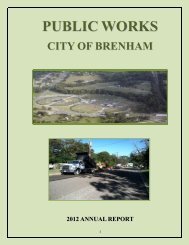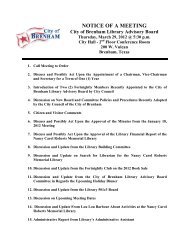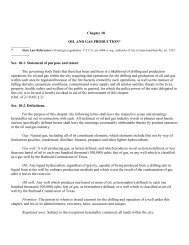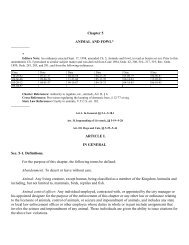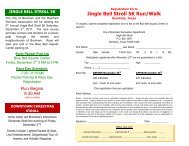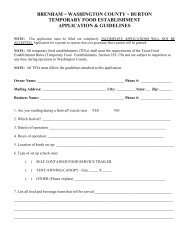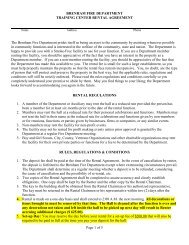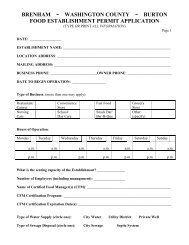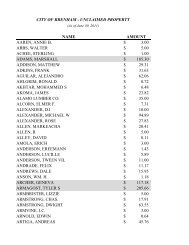Wastewater Treatment - City of Brenham
Wastewater Treatment - City of Brenham
Wastewater Treatment - City of Brenham
Create successful ePaper yourself
Turn your PDF publications into a flip-book with our unique Google optimized e-Paper software.
<strong>Wastewater</strong> <strong>Treatment</strong><br />
• Where does wastewater go when it leaves your<br />
house?
Let’s s take a look<br />
• The process includes:<br />
– Collection <strong>of</strong> wastewater<br />
– Primary <strong>Treatment</strong><br />
– Secondary <strong>Treatment</strong><br />
– Solids Handling<br />
– Influent and Effluent Monitoring
<strong>Wastewater</strong> Collection<br />
• It is very important that<br />
wastewater arrive at the<br />
treatment plant in<br />
relatively good condition.<br />
• A collection system will<br />
have miles <strong>of</strong> pipeline<br />
with the common goal <strong>of</strong><br />
bringing the used water<br />
to the treatment facility.
Collection<br />
• Lift Stations are an asset<br />
to a collection system.<br />
• Lift Stations will lift the<br />
wastewater from an area<br />
where the water can no<br />
longer move by gravity<br />
force, and pump it to a<br />
higher level where it will<br />
resume gravity fall.
We made it to the <strong>Treatment</strong><br />
Plant<br />
• At the <strong>City</strong> <strong>of</strong> <strong>Brenham</strong><br />
<strong>Wastewater</strong> <strong>Treatment</strong><br />
Plant, treatment begins at<br />
the influent pump station.<br />
• <strong>Wastewater</strong> is pumped<br />
up into the facility by<br />
Submersible Pumps so<br />
the remaining processes<br />
are primarily gravity fed.
Removal <strong>of</strong> Large Particles<br />
• After wastewater is<br />
pumped into the<br />
Headworks <strong>of</strong> the<br />
plant, it will flow<br />
through a fine screen<br />
to remove large<br />
particles <strong>of</strong> waste.
Primary <strong>Treatment</strong><br />
• For proper treatment,<br />
inorganics should be<br />
removed prior to<br />
secondary treatment.<br />
• This occurs in a cone<br />
shaped chamber.<br />
• The sand and grit will<br />
settle to the bottom<br />
and be pumped out.
Secondary <strong>Treatment</strong><br />
• Secondary or Biological<br />
<strong>Treatment</strong> is where the<br />
magic happens.<br />
• This is where the<br />
prescreened wastewater<br />
meets the “bugs”.<br />
• In the wastewater<br />
business, “bugs” refer to<br />
the bacteria, protozoa,<br />
and other microorganisms<br />
that feed on bacteria<br />
found in wastewater.
Secondary <strong>Treatment</strong><br />
• Secondary <strong>Treatment</strong><br />
occurs in an Aeration<br />
Basin.<br />
• Large blowers force air<br />
into these basins to keep<br />
the “bugs” happy.<br />
• A good dissolved oxygen<br />
level is between 2 and 4<br />
mg/l.
Regulating Conditions in the<br />
Aeration Basin<br />
• Air can be regulated using the<br />
blowers, however we must<br />
also regulate the amount <strong>of</strong><br />
“bugs” in the aeration basin.<br />
• “Bugs” are removed and<br />
brought back to the aeration<br />
basin, a process that will be<br />
evident soon.<br />
• Due to constant reproduction,<br />
some “bugs” must be removed<br />
and disposed <strong>of</strong>, also covered<br />
soon.
Clarification<br />
• When the treated water<br />
leaves the aeration basin,<br />
it flows into a clarifier.<br />
• The clarifier is designed<br />
for solids settling so there<br />
is not any air being<br />
forced into the clarifiers.<br />
• The “bugs” that traveled<br />
over to the clarifier settle<br />
to the bottom and the<br />
clear water flows over the<br />
weirs.
Return Activated Sludge<br />
• Return Activated<br />
Sludge (RAS), the<br />
“bugs” that collect on<br />
the floor <strong>of</strong> the<br />
clarifier are returned<br />
to the aeration basin<br />
to continue breaking<br />
down bacteria in the<br />
wastewater.
Waste Activated Sludge<br />
• As mentioned previously,<br />
constant reproduction will<br />
force an operator to dispose <strong>of</strong><br />
or “waste” some <strong>of</strong> the “bugs”<br />
in the process in order to keep<br />
the food to microorganism<br />
ratio at a sustainable level.<br />
• The product <strong>of</strong> this wasting is<br />
called Waste Activated Sludge<br />
(WAS) and it will be sent to a<br />
digester which will be visited<br />
later.
Disinfection<br />
• The treated water must<br />
be disinfected before it<br />
leaves the facility.<br />
• The <strong>City</strong> <strong>of</strong> <strong>Brenham</strong> uses<br />
chlorine to disinfect the<br />
treated water.<br />
• Once disinfection has<br />
been achieved, sulfur<br />
dioxide is applied to<br />
remove any residual<br />
chlorine that could be<br />
harmful to wildlife.
Effluent<br />
• It is our goal to produce<br />
a clean environmentally<br />
safe effluent.<br />
• We want to see a low<br />
BOD, a neutral pH, low<br />
TSS, as well as low<br />
ammonia in the effluent.<br />
• Quality control tests are<br />
run to ensure the plant is<br />
running within permit<br />
regulations.
Lab Tests<br />
• BOD-Biochemical<br />
Biochemical<br />
Oxygen Demand<br />
• TSS-Total Total Suspended<br />
Solids<br />
• Ammonia<br />
• Chlorine Residual<br />
• Temperature<br />
• Dissolved Oxygen
Lab Tests<br />
• BOD-indicates strength <strong>of</strong> wastewater; can tell an<br />
operator how much oxygen will be used by the biomass<br />
found in wastewater and wastewater effluent.<br />
• TSS-measure the total suspended solids or what will<br />
become oxygen demanders in receiving stream<br />
• Ammonia is extremely toxic to fish and wildlife<br />
• Chlorine residual ensures disinfection is occurring<br />
• Temperature shifts can alter receiving streams and<br />
magnify effects <strong>of</strong> other factors in stream health<br />
• Dissolved oxygen in critical in plant and fish survival
What’s s next?<br />
• We have treated the water better than the<br />
State standards<br />
• Now it is time to take care <strong>of</strong> the solids<br />
that were wasted out <strong>of</strong> the clarifier, the<br />
Waste Activated Sludge.<br />
• Let’s s go back to the clarifier and pick up<br />
the process <strong>of</strong> solids handling.
Solids Handling<br />
• The purpose <strong>of</strong> solids<br />
handling is to dewater<br />
and reduce pathogens<br />
present in activated<br />
sludge.<br />
• The Waste Activated<br />
Sludge is moved from the<br />
clarifiers to the digester.<br />
• There are several parts to<br />
the digester.
Digester<br />
• The waste activated<br />
sludge will enter the rapid<br />
mix chamber.<br />
• From the mix chamber, it<br />
will move into the gravity<br />
thickener.<br />
• In the gravity thickener,<br />
the solids will settle to<br />
the bottom and be<br />
removed by air lift<br />
pumps.<br />
• The solids go into the<br />
large digestion basins.
Digester<br />
• The thickened sludge<br />
will stay in the<br />
digester<br />
approximately 30<br />
days.<br />
• After digestion, the<br />
sludge is ready to be<br />
dewatered.
Belt Press<br />
• Digested sludge is<br />
mixed with polymer<br />
and applied to the<br />
belt press.<br />
• Excess water is<br />
squeezed out by the<br />
two belts.
Lime Stabilization<br />
• The <strong>City</strong> <strong>of</strong> <strong>Brenham</strong> uses<br />
lime stabilization to<br />
achieve Class A Biosolids.<br />
• Lime is added and the<br />
sludge is sent through<br />
ovens to achieve a<br />
specified temperature to<br />
reduce pathogens as well<br />
as vector attraction.
Land Application<br />
• The sludge is ready to<br />
be taken out and<br />
applied as a soil<br />
amendment.<br />
• It can be used on<br />
ranchland, but not on<br />
anything that will be<br />
directly involved in<br />
food for human<br />
consumption.
Importance <strong>of</strong> <strong>Treatment</strong><br />
• It is vital to treat our wastewater in order to<br />
keep our streams and rivers healthy.<br />
• Our permit requires that we treat the<br />
wastewater in accordance with very high<br />
standards to help dilute pollution from non-point<br />
sources which also makes its way to streams<br />
and rivers.<br />
• The stream that wastewater effluent is<br />
discharged into at one location may be a source<br />
<strong>of</strong> drinking water to another community.



